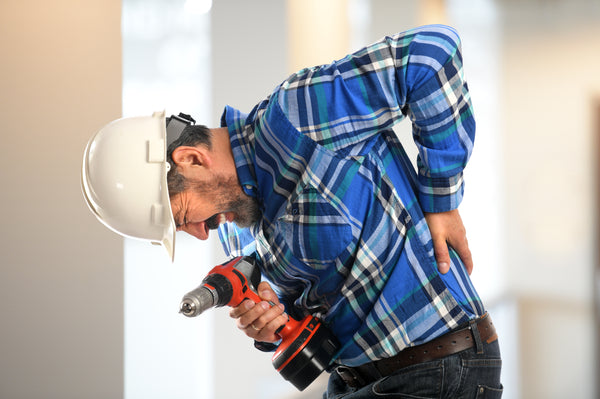Posture Tips for Construction Workers to Protect Their Back and Neck

Employing over 7 million workers in the U.S., the construction industry accounts for nearly 5 percent of total workers, according to the U.S. Bureau of Labor Statistics, making it one of the largest industries. But while construction is part of the backbone of the U.S. economy, the physically taxing work often takes its toll on the literal backs (and necks) of many construction workers.
This article will provide valuable tips to help construction workers maintain their physical well-being, including maximizing the benefits of research-backed Posture Pump® products.
The Prevalence of Back And Neck Pain In Construction
In a recent study published in PLoS One (2021), it was revealed that lower back pain ranks as the leading cause of disability globally. Specifically, among construction workers surveyed, approximately 50% reported experiencing lower back pain. The study also highlighted the vulnerability of construction workers, with nearly 80% of their working postures found to be harmful to the musculoskeletal system.
But here’s the rub (or lack thereof, literally): Over 60% of the construction workers reporting low back pain did nothing to relieve the pain within the prior year that the respondents took the survey.
More Constructive Insights:
-
Lower back and neck pain is one of the leading factors of extended sick leave and affects approximately 80% of construction workers during their careers.
-
Construction workers who worked for more than six years had higher musculoskeletal symptoms.
The Most Common Back and Neck Injuries in Construction
Improper lifting techniques and overexertion while lifting heavy objects can lead to strains and sprains in the back and neck muscles. Falls, even if not severe, can cause herniated discs and spinal cord damage. Moreover, doing the same tasks with poor posture can cause repetitive stress injuries to the back and neck.

Importance of Proper Techniques and Equipment
Every construction worker should receive training in proper lifting techniques, which involve bending at the knees, keeping the back straight, avoiding twisting the body, and using leg muscles to lift objects.
Although construction workers may have little control over which equipment is being used, tasks should be performed with ergonomic best practices in mind and vibration-dampening features. If not provided, construction workers should invest in the best shock-absorbing construction boots to reduce stress on the back and neck.
Back and Neck Relief For Construction Workers (Minimal Effort)
Posture Pump® products are designed to help relieve back and neck pain by providing gentle and targeted traction to the spine. These devices can be particularly beneficial for construction workers, who often experience strain and discomfort due to the physical demands of their work.
With a patented air-cell technology that provides a unique form of spinal decompression, Posture Pump® utilizes these air cells underneath the neck/lower back region. When the Posture Pump® is inflated, it creates a gentle expansion and works to reshape the spine, promoting proper alignment and reducing pressure on the discs, nerves, and other structures. The device can be used at home and is portable so that you can also use it in the flatbed of a truck or on the floor while on a work break.
With daily use of just 5-15 minutes per day, Posture Pump® could relieve or eliminate the strain caused by prolonged periods of poor posture or repetitive movements in construction work. Designed to help restore the natural curves of the spine, Posture Pump® is especially therapeutic on the neck and lower back regions.
Backed by several research studies, Posture Pump® has provided back and neck relief for many users, including Stanley W. of Fayetteville, NC, who expressed:
“After 33 years working in a factory, I had back pain, as well as pain in my left leg. I had an MRI which showed 2 bulging discs and 1 herniated disc. I had decompression treatments which cost $2400 out of pocket, and only helped me get to about 80% pain relief. Ever since I found out about Posture Pump® (PENTAVEC® Model 2500) and started using regularly … I’m 100% pain free.”
Exercise and Conditioning for Injury Prevention
Although Posture Pump® products can offer significant relief, construction workers should implement a holistic pain-relief prevention or mitigation routine. Part of this strategy involves strengthening and stretching exercises.Regular strength training exercises that target the deep core musculature of the abominable wall and the back muscles can improve stability and reduce the risk of injury. Exercises like planks, squats, and deadlifts can help build strength in these areas. If you’re unsure how to perform these exercises correctly, consider investing in a few sessions with a personal fitness trainer.
Stretching exercises, including neck stretches, shoulder rolls, and hamstring stretches, can help maintain flexibility and mobility, reducing the risk of muscle imbalances and strain. In addition, getting some aerobic activity such as brisk walking or cycling may improve blood flow to the body. This may lead to better nourishment and hydration of the vertebrae, thereby reducing strain and tension.
After a full day on the job site, a construction worker may not have the energy to exercise or stretch. However, even a brief exercise and stretching routine can be highly effective at managing back and neck pain over time.
Conclusion
Construction, known as one of the most physically demanding occupations, places workers at a higher risk for chronic back and neck pain. However, by using Posture Pump® products, which require minimal effort and only 5 - 15 minutes of usage per day, the curvature and hydration of the spine and discs can be restored, leading to relief.
In addition, using proper lifting techniques and ergonomic equipment, taking frequent mini-stretching breaks, and maintaining a regular core exercise and stretching routine may also help construction workers stay healthy on the job.
Questions about Posture Pump® Disc Hydrators®? Visit our FAQ page or call 1-800-632-5776.

Leave a comment